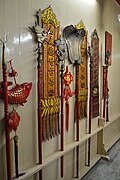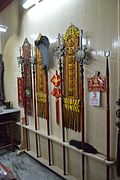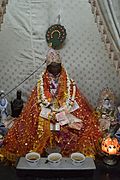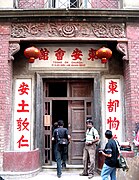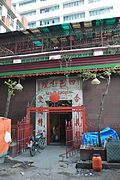A Chinatown is an ethnic enclave of Chinese people located outside mainland China, Hong Kong, Macau or Taiwan, most often in an urban setting. Areas known as "Chinatown" exist throughout the world, including Europe, North America, South America, Asia, Africa and Australasia.

The Jade Emperor in Chinese culture, traditional religions and myth is one of the representations of the first god. In Daoist theology he is the assistant of Yuanshi Tianzun, who is one of the Three Pure Ones, the three primordial emanations of the Tao. He is also the Cao Đài of Caodaism known as Ngọc Hoàng Thượng đế. He is often identified with Śakra in Chinese Buddhist cosmology. In Korean mythology he is known as Haneullim.

Yau Ma Tei is an area in the Yau Tsim Mong District in the south of the Kowloon Peninsula in Hong Kong.
Hong Kong counts approximately 600 temples, shrines and monasteries. While Buddhism and Christianity are the most widely practiced religions, most religions are represented in the Special Administrative Region.

Shau Kei Wan or Shaukiwan is a neighborhood in the Eastern District of Hong Kong Island. The area is bordered by Chai Wan to the east, Mount Parker to the south, Sai Wan Ho to the west, and Victoria Harbour to the north.

Chinese folk religion, also known as popular religion, is a polyphyletic term used to describe the diversity of practices in areas generally termed "religion", of persons of Chinese heritage, including the Chinese diaspora. Vivienne Wee described it as "an empty bowl, which can variously be filled with the contents of institutionalized religions such as Buddhism, Taoism, Confucianism, the Chinese syncretic religions." This may include the veneration of forces of nature and ancestors, exorcism of demonic forces, and a belief in the rational order of nature, balance in the universe and reality that can be influenced by human beings and their rulers, as well as spirits and gods. Worship is devoted to a multiplicity of gods and immortals, who can be deities of phenomena, of human behaviour, or progenitors of lineages. Stories regarding some of these gods are collected into the body of Chinese mythology. By the 11th century, these practices had been blended with Buddhist ideas of karma and rebirth, and Taoist teachings about hierarchies of Gods, to form the popular religious system which has lasted in many ways until the present day. Since the 1950s, Chinese folk-religion is also sometimes referred to as Shenism or Shénism. In this context, shen refers to a spirit or a deity. The term 'Shenism' was first used by A. J. A Elliot in 1955. The term 'Chinese folk religion' is not used inside China.
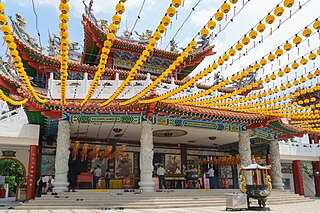
The Thean Hou Temple is a six-tiered temple of the Chinese sea goddess Mazu located in Kuala Lumpur, Malaysia. It is located on 1.67 acres (6,758 m2) of land atop Robson Heights on Lorong Bellamy, overlooking Jalan Syed Putra. It was completed in 1987 and officially opened in 1989. The temple was built by Hainanese living in Malaysia and the property belongs to and is run by the Selangor and Federal Territory Hainan Association. It is one of the largest temples in Southeast Asia.
Religion in Hong Kong is characterized by a multi-faith diversity of beliefs and practices.

Sha Tin, also spelt Shatin, is a neighbourhood along Shing Mun River in the eastern New Territories, Hong Kong. Administratively, it is part of the Sha Tin District. Sha Tin is one of the neighbourhoods of the Sha Tin New Town project.
A kwoon is a training hall for Chinese martial arts.

Tiretta Bazaar, is a neighborhood near Lalbazar in Central Kolkata. It is usually called Old China Market. Most of the Hakka Chinese people have moved to Tangra near EM Bypass now. The locality was once home to 20,000 ethnic Chinese Indian nationals, but now the population has dropped to approximately 2,000. The traditional occupation of the Chinese Indian community in Kolkata had been working in the nearby tanning industry as well as in Chinese restaurants. The area is still noted for the Chinese restaurants where many people flock to taste traditional Chinese and Indian Chinese cuisine.

Religion in Taiwan is characterised by a diversity of religious beliefs and practices, predominantly those pertaining to the continued preservation of the ancient Chinese culture and religion. Freedom of religion is inscribed in the constitution of the Republic of China (Taiwan), and ranks high at 9.2 on the freedom scale in 2018 according to world bank.

Chinese temple architecture refer to a type of structures used as place of worship of Chinese Buddhism, Taoism or Chinese folk religion, where people revere ethnic Chinese gods and ancestors. They can be classified as:

Sam Kai Vui Kun, known also as Kuan Tai Temple, is located in front of St. Dominic’s Market Complex, near Senado Square in Sé, Macau, China. The temple was built in 1750.
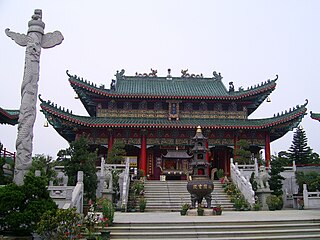
Taoism in Hong Kong is the religion of approximately 14% of the population. This figure did not include the large number of local population who are following Chinese folk religious traditions without indicating their religious affiliation.
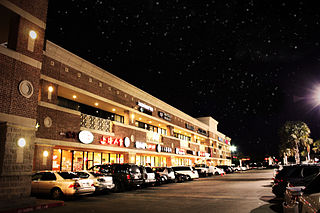
The Houston area population includes a large number of people with Chinese ancestral backgrounds. According to the American Community Survey, as of 2013, Greater Houston has 72,320 residents of Chinese origin.
A Taoist temple is a place of worship in Taoism.

The Chicago metropolitan area has an ethnic Chinese population. As of 2010, there are 43,228 Chinese Americans who live in Chicago, 1.6% of the city's population. This population includes native-born Chinese as well as immigrants from Mainland China, Taiwan, Hong Kong and Southeast Asia, and also racially mixed Chinese.

Chinese folk religion plays a dynamic role in the lives of the overseas Chinese who have settled in the countries of this geographic region, particularly Burmese Chinese, Singaporean Chinese, Malaysian Chinese, Thai Chinese and Hoa. The Indonesian Chinese, by contrast, were forced to adopt en masse either Buddhism or Christianity in the 1950s and 1960s, abandoning traditional worship, due to Indonesia's religious policies which forbade Chinese traditional religion. Some Chinese Filipinos also still practice some Chinese traditional religions, besides Christianity of either Roman Catholicism or Protestantism, of which some have also varyingly syncretized traditional Chinese religious practices with. Chinese folk religion, the ethnic religion of Han Chinese, "Shenism" was especially coined referring to its Southeast Asian expression; another Southeast Asian name for the religion is the Sanskrit expression Satya Dharma.



